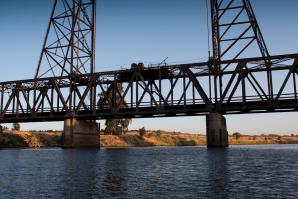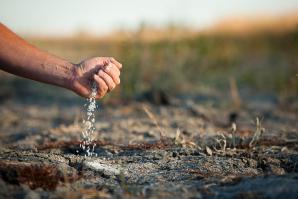On Twitchell Island, near the Delta town of Isleton, tules covering 15 acres grow twice as tall as the average man. A gravel road separates the wetlands from a cornfield, sunken 25 feet at its lowest point. Every year, the wetlands’ soil rises a few inches, while the cornfield sinks. The discovery that tules increase land elevation in the Sacramento-San Joaquin Delta is fueling a joint experiment conducted by the state Department of Water Resources and the U.S. Geological Survey, along with UC Davis researchers, other universities and private consultants.
The state began the tule pilot project in 1997 in an effort to protect its water supply. The 738,000-acre Delta is the hub of the state’s water system, providing water to about two-thirds of the state’s 38 million residents. Here, the freshwater from rivers mixes with salt water from the Pacific Ocean, forming the largest estuary on the West Coast. Its 700 miles of channels and sloughs are protected by 1,100 miles of levees. When settlers began building the levees in the mid-1800s, they drained the land and exposed the carbon-rich peat soil to oxygen, causing it to vaporize. As the land sinks, water pressure on the levees increases, making them vulnerable to collapse. A catastrophic failure would flood the Delta with salt water, interrupting water deliveries statewide.
Subsidence is especially severe in the western Delta, where the tule project is under way. In some places, the land has sunk to 30 feet below sea level. “Not only does that differential put a greater pressure on the levees, but in the event of a breach, that’s a lot more water … that would have to be pumped out,” says Bryan Brock, program manager of the tule research project for the Department of Water Resources.
The pilot project began as a way to test whether growing tules, a native plant that once blanketed the Delta, would raise the land elevation. While questions remain, researchers have made several findings. They discovered tules can increase the soil level as much as two inches a year. Tules store carbon in their roots, which pushes the ground upward. And as the plants die and grow back each year, soil accumulates on the surface. Flooding the ground with water, as opposed to draining and plowing it to cultivate a crop such as corn, can prevent as much as an inch of soil loss per year for a net annual accumulation of about three inches.
Researchers knew that tules trap carbon in their roots, so they began investigating their potential to reduce greenhouse gases. While tules release potent greenhouse gases — methane and nitrous oxide — preliminary findings show net greenhouse gas absorption is about 25 tons per acre annually.
“There are few other natural systems for carbon sequestration that have the potential to lock away that much carbon anywhere, certainly in California and probably throughout the U.S.,” says Stuart Siegel, wetlands project manager and president of Wetlands and Water Resources Inc. in San Rafael.
The pilot project was scheduled to receive a three-year $12.3 million infusion of state funding this year to expand to a 600-acre experiment, but the state budget has frozen bond sales. That stopped research in January until funding resumes.
The scientists hope the experiment will transfer to the marketplace. Possibilities include farmers replacing crops with tules and selling credits for offsetting carbon dioxide after a carbon trading market develops, or being paid by a developer to create habitat. The project also could apply to the public sector with government agencies paying farmers to grow tules or set up tule wetlands themselves to meet the state’s goal of reducing greenhouse gas emissions to 1990 levels by 2020.
Several venture capitalists are interested in financing tule wetlands in exchange for generating revenue from carbon credits, says Greg Young, principal of Basic 3 Inc., a Sacramento company working on the project. His company is examining, in part, how much money farmers could make by growing tules and selling carbon-offset credits compared to other crops.
The Department of Water Resources and USGS, along with universities and private consultants, recently began conducting a second subsidence-reversal pilot project with another crop. In April, researchers planted 175 acres of medium-grain rice on Twitchell Island with the hope of planting the rest of the 320-acre parcel next year. The state plans to sell its harvest to a subsidiary of Anheuser-Busch Co. for about $250,000. While researchers expect rice to stop subsidence rather than reverse it, the grain has an advantage over tules in that it has a ready-made retail market.
Project leaders plan to work with the University of California Cooperative Extension, which will explain to farmers how rice cultivation can benefit them and how to minimize the potential air and water pollution from growing rice on a large scale.
Growing rice is an “alternative to what most of Delta agriculture is today, which is not sustainable,” says Steven Deverel, a hydrologist and president of HydroFocus Inc., a Davis-based consulting firm overseeing the project.
Recommended For You

What’s to Fallow
After Years of drought, the legislature's historic water deal is just the beginning
This is the final story in a four-part series on water. This month, we’ll wrap up by examining upcoming issues in 2010. Past installments of this series have explored water issues ranging from storage, conservation and desalination, to impacts of a peripheral canal on the Sacramento-San Joaquin Delta.

Of Rice and Men
On the Cover: Parched by years of drought, thousands of California’s rice fields lie barren
In the Sacramento Valley, where 97 percent of the state’s rice crop is grown, family farmers have been forced to fallow cropland they have worked for generations. The economic hit has been hard and true, affecting not just farmers, but seed distributors, equipment dealers and anyone else with a thumb in the rice business. The drought could cost Central Valley farmers and communities $1.7 billion this year and may lead to more than 14,500 layoffs.


